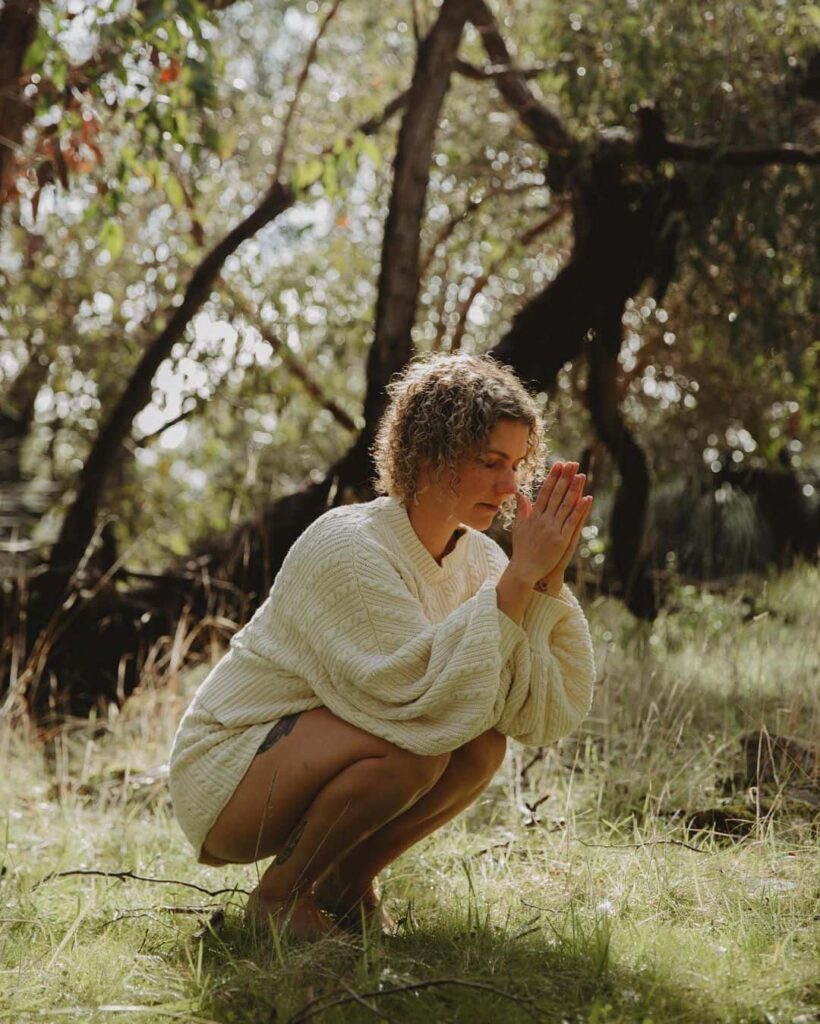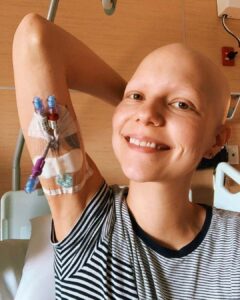AML survivor Sophie Gray shares the role yoga and mindfulness played in her recovery

Sophie was diagnosed with AML in 2019, aged 29. She had a stem cell transplant later the same year from an unrelated donor and has been in remission ever since. After leaning on her yoga and mindfulness practice heavily through her recovery, Sophie underwent her yoga teacher training and teaches in Adelaide.
She has undertaken further education in accessible yoga, yoga for cancer, and working with those with a disability. She is now facilitating her course ‘Yoga after Cancer – Coming Home to the Body’ in person in Adelaide and shortly online.
The Leukaemia Foundation asked Sophie some questions about her experience with complementary therapies.
1. How did complementary therapy fit in with your treatment and recovery?
I really lent on complementary therapies a lot through my treatment and recovery. When I was diagnosed, I got in touch with a naturopath who specialised in cancer patients, and had a plan for foods to eat to promote energy, health and wellbeing. They also provided details about supplements to take (I had told them my specific chemo regime) – although I didn’t take these whilst on active treatment on my doctors advice. A local holistic cancer centre in Adelaide has a great programme with subsidised practitioners, I was so grateful to be able to use this service to reach treatments such as acupuncture and acupressure, reiki, massage and a great library. I used my yoga and meditation practise a lot at this time, and a lot of people in my community reached out with ways to help – massages, etc etc which was amazing and so helpful at this time. I was juicing a lot and making sure I was eating healthily and incorporating movement when I could. I had about a 4/5 week break between my last chemotherapy and being admitted again for my stem cell transplant, and I used this time as wisely as I could – seeking out treatments and things to ‘fill my cup up’ each day, so much so that when I arrived in hospital for my transplant I commented that I felt I’d just been at a spa holiday for the past month. Taking the time and energy on myself meant I felt ready for this next treatment.
2. What particular therapy modalities did you use?
Lots – I can’t think of much I haven’t tried – massage, reiki, acupuncture/acupressure, talk therapy, dietary changes, art therapy, meditation and visualisation, yoga.
3. When looking at complementary therapies, how did you appraise the information to ensure it was right for you?
I made sure that I was going to qualified professionals and those with an understanding of cancer treatment – this was what was so helpful about receiving therapies at the cancer care centre, as they already had an understanding of this and of risks involved. I would let them know what was happening with treatment and how that could effect things – ensuring I had a good amount of platelets before receiving a massage and making sure that these were gentle, no cupping etc. For anything that I was not sure about, I ran these past my Drs/nurses. I also did a lot of self research – what could be good for mind/body/soul etc. Some things such as walks and time in nature, mindfulness practises, and connecting with others were good ways to replenish my cup when I wasn’t able to do other treatments.
4. Did you speak to your treating health care professionals about the use of complementary therapies in managing your health / wellbeing throughout treatment recovery?

Once I left after transplant, I would run supplements past the pharmacist who worked in the transplant ward, for example I wanted to start a course of probiotics straight away to try and build back my gut microbiome but he explained this could be risky being on immunosuppressants. He also checked for contraindications across the medication I was being prescribed. It was good to know why I wasn’t able to take something, which provided me with a rationale, and knowing when I would be able to take something.
I let my consultant know what supplements I’m taking, what I’ve found beneficial. I’m really thankful that I found a team supportive of my choices, and one that can explain risks to me so I can make appropriate decisions. My Consultant understands that this is important to me and allows me to have this choice, sometimes I have presented him with studies about something being beneficial and he has looked into it. It is good to have this supportive team and definitely would have impacted me were they not onboard with complementary therapies.
Last updated on March 20th, 2024
Developed by the Leukaemia Foundation in consultation with people living with a blood cancer, Leukaemia Foundation support staff, haematology nursing staff and/or Australian clinical haematologists. This content is provided for information purposes only and we urge you to always seek advice from a registered health care professional for diagnosis, treatment and answers to your medical questions, including the suitability of a particular therapy, service, product or treatment in your circumstances. The Leukaemia Foundation shall not bear any liability for any person relying on the materials contained on this website.